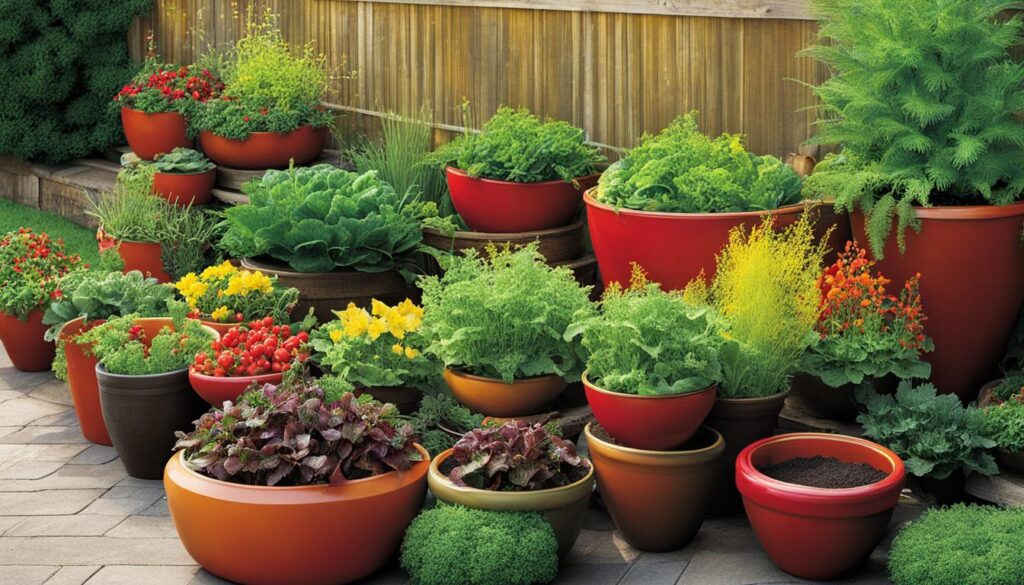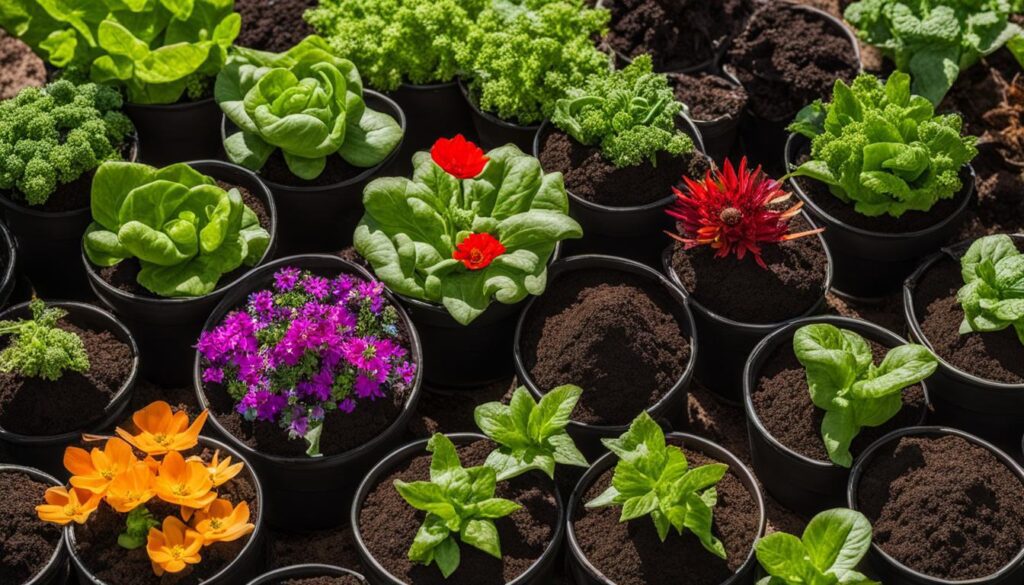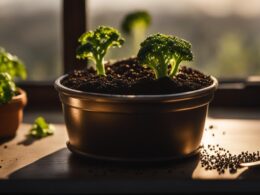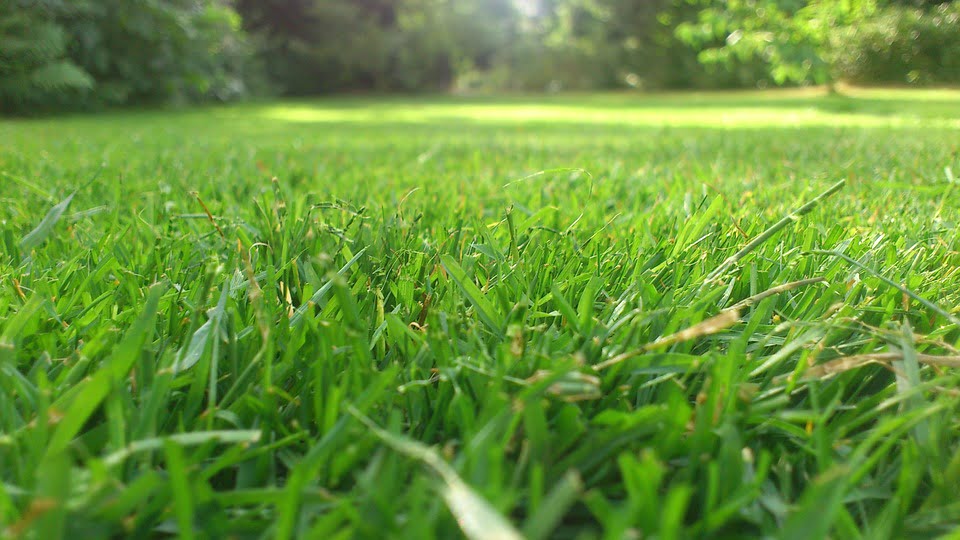Are you limited on space but still want to grow your own fresh vegetables? Container vegetable gardening is the solution for you. Whether you have a small patio or rooftop, you can create an ideal growing environment and enjoy a bountiful harvest right at your fingertips. But before you get started, you may be wondering, can potting mix be used for vegetables?
In container gardening, choosing the right size pot for different vegetables is important. But what about the potting mix? Can you use it for growing vegetables? The answer is yes, potting mix can be used for vegetables in container gardening. In fact, using premium potting soil is recommended as it provides good drainage and air flow, which are essential for successful vegetable growth.
Key Takeaways:
- Potting mix can be used for growing vegetables in container gardening.
- Choosing the right size pot is crucial for the growth and development of different vegetables.
- Premium potting soil provides good drainage and air flow, creating an ideal environment for vegetable growth.
- Placement of containers in a sunny spot and proper watering are also essential for successful vegetable growth.
- Container vegetable gardening is a flexible and convenient way to grow your own fresh vegetables, even in small spaces.
Container Vegetable Gardening: Size Matters
When it comes to container vegetable gardening, the size of the pot matters. Different vegetables have different space requirements, and choosing the right pot size is crucial for their growth and development.
A 10-inch pot, for example, is suitable for growing leaf lettuce, Swiss chard, bush beans, and other small plants. If you’re planning to grow dwarf sweet corn, cabbage, peas, or various leafy vegetables, a 14-inch pot would be more appropriate. On the other hand, larger vegetables like pole beans, broccoli, eggplant, tomatoes, and others will need an 18-inch pot or larger.
When deciding on the pot size, it’s important to consider the number of plants you want to grow in each pot. If you’re planning on growing multiple plants, you may need a larger pot to accommodate their root systems and ensure they have enough space to thrive.
The Importance of Potting Soil in Container Gardening
When it comes to container gardening, the type of potting soil you choose can make all the difference in the success of your vegetable garden. Regular garden soil is not recommended for container gardening because it can become compacted and hinder proper drainage and aeration. That’s why it’s important to opt for a high-quality potting mix that is specifically formulated for this type of gardening.
Using a premium potting soil provides several benefits for your plants in containers. First, potting mixes are lighter than garden soil, which allows for better drainage and airflow. This is important because containers can easily become waterlogged, drowning the roots and causing rot. The well-draining nature of potting soil helps prevent this issue.
Furthermore, potting soil retains moisture more effectively than regular garden soil. This is crucial in container gardening, as pots tend to dry out faster than in-ground gardens. The ability of potting mixes to retain moisture means that your plants will have a more consistent water supply, reducing the risk of drought stress.
Selecting the Right Potting Soil
When choosing potting soil for your container vegetable garden, it’s important to look for a reputable brand that offers a mix specifically designed for container gardening. Miracle-Gro® Potting Mix and Miracle-Gro® Moisture Control® Potting Mix are two popular options that provide the ideal environment for root growth in pots. These mixes are formulated with the proper balance of organic matter, perlite, and other additives to ensure optimal plant health and growth.
By selecting the right potting soil for your container gardening needs, you can create the ideal growing environment for your vegetables. This will help promote healthy root development, improve nutrient uptake, and ultimately, lead to a bountiful harvest of homegrown greens.
Choosing the Right Spot for Your Container Vegetable Garden
When it comes to container gardening, choosing the right spot for your vegetables is crucial for their growth and overall success. One of the key factors to consider is finding a sunny spot for your containers. Vegetables thrive in sunlight, and they require at least six hours of direct sunlight each day. Ensure that the spot you choose receives ample sunlight throughout the day, as this will help promote healthy growth and abundant harvests.
However, it’s important to be cautious when placing your containers on pavement or other hard surfaces, as they tend to heat up more quickly. This excessive heat can cause the soil to dry out faster, requiring you to water your plants more frequently. To prevent this, consider placing your containers on a stand or using a layer of mulch to help regulate soil temperature and retain moisture.
Container gardening also offers the flexibility to take advantage of micro-climates. By strategically placing your containers along a south-facing wall, you can capitalize on the warmth provided by the sun. This can help warm up the soil earlier in the spring, allowing for earlier planting and an extended growing season. Similarly, in the autumn, placing containers along a south- or west-facing wall can help retain heat as the temperature drops, prolonging the harvest season as frost approaches.
By carefully selecting the right spot for your container vegetable garden, you can optimize sunlight exposure, manage soil temperature, and make the most of micro-climates, setting the stage for a bountiful harvest.
Table: Sunlight Requirements for Common Vegetables
| Vegetable | Sunlight Requirements |
|---|---|
| Tomatoes | Full sun (6-8 hours) |
| Lettuce | Partial shade (4-6 hours) |
| Cucumbers | Full sun (6-8 hours) |
| Peppers | Full sun (6-8 hours) |
| Carrots | Partial shade (4-6 hours) |
“Choosing the right spot for your container vegetable garden is like finding the perfect home for your plants. Give them the sunshine they crave, protect them from extreme heat, and take advantage of the unique micro-climates around your home. With a little planning, your veggies will thank you with their bountiful harvest!”
Tips for Proper Watering in Container Gardening
Proper watering is essential for the success of your container vegetable garden. Pots tend to dry out faster than in-ground gardens, so it’s important to establish a consistent watering routine. Here are some tips to help you water your container garden effectively:
1. Check the Soil Moisture Daily
Container plants can quickly become dehydrated, especially during hot summer months. To ensure your vegetables receive adequate moisture, check the soil moisture daily. Insert your finger into the soil up to the second knuckle, and if the top inch feels dry, it’s time to water.
2. Water Thoroughly and Slowly
When watering your container garden, aim for a slow and thorough watering session. This will allow the water to penetrate the entire root ball and ensure proper hydration. Avoid quick, shallow watering, as it may not reach the deeper roots and can lead to uneven moisture levels.
3. Use the Drainage Holes
Containers should have drainage holes at the bottom to prevent waterlogged soil. These holes allow excess water to drain out and help prevent root rot. When watering, make sure to saturate the soil until water starts to flow out of the drainage holes. This indicates that the potting mix has absorbed enough moisture.
4. Consider Drip Irrigation Systems
For larger container gardens or if you have limited time for watering, consider installing a drip irrigation system. This system delivers precise amounts of water directly to the soil, reducing the risk of overwatering and ensuring consistent moisture levels. Drip irrigation can be a convenient option, especially if you’re maintaining multiple containers.
By following these watering tips, you can provide your container vegetable garden with the moisture it needs to thrive. Remember to monitor the soil moisture regularly and adjust your watering schedule based on weather conditions and the specific needs of your plants.
Nutrient Needs of Container Vegetable Plants
Feeding your container vegetable plants with the right nutrients is essential for their growth and productivity. Unlike plants grown in the ground, container plants have limited access to natural sources of nutrients. Therefore, it’s important to provide them with a balanced diet to ensure they thrive.
One option for providing essential plant nutrients is to mix a continuous release plant food into the soil about a month after planting. Miracle-Gro® Shake ‘N Feed for Tomatoes, Fruits & Vegetables is a popular choice. This plant food contains a balanced blend of essential micronutrients for vegetable plants and is specifically formulated to promote healthy growth and abundant yields.
When using a continuous release plant food, it’s important to follow the label instructions for feeding. Applying too much fertilizer can burn the roots and harm the plants. On the other hand, using too little may result in nutrient deficiencies and stunted growth. By following the recommended dosage, you can provide the right nutrient balance for your container vegetable plants.
| Nutrient | Function | Signs of Deficiency |
|---|---|---|
| Nitrogen (N) | Stimulates leaf and stem growth | Pale yellow leaves, stunted growth |
| Phosphorus (P) | Promotes root development and flowering | Poor root growth, reduced flowering |
| Potassium (K) | Aids in overall plant health and fruit development | Weak stems, small fruits, yellowing leaves |
| Calcium (Ca) | Strengthen cell walls and prevent blossom end rot | Rotting of the blossom end of fruits |
| Magnesium (Mg) | Essential for chlorophyll production | Yellowing leaves with green veins |
| Iron (Fe) | Important for chlorophyll formation and overall plant health | Yellowing leaves, stunted growth |
In addition to providing the right nutrients, it’s important to monitor the health of your plants. Regularly inspect the leaves for any signs of nutrient deficiencies, such as yellowing or stunted growth. Adjust the feeding regimen if necessary to address any nutrient imbalances.
By feeding your container vegetable plants with the right nutrients, you can ensure they have the resources they need to thrive and produce a bountiful harvest.
Expanding Options: Growing Vegetables in Soil Bags
If you have limited space or want an alternative to traditional pots, growing vegetables in soil bags can be a viable option. This method allows you to utilize different types of bags as containers for growing vegetables with shallow root systems. Salad greens, lettuce, kale, beets, turnips, cabbage, and cherry tomatoes are some of the vegetables that can be successfully grown in soil bags. It’s important to poke drainage holes in the bottom of the bags and cut off the top portion to create a planting area. Using the appropriate potting soil and selecting suitable vegetable varieties is crucial for successful growth in soil bags.
Benefits of Growing Vegetables in Soil Bags
Growing vegetables in soil bags offers several benefits for container gardening enthusiasts. Here are some advantages:
- Cost-effective: Soil bags are an affordable option compared to traditional pots or containers.
- Easy mobility: Soil bags are lightweight and portable, allowing you to move them around to find the best sun exposure.
- Increased yield: Vegetables grown in soil bags can yield a bountiful harvest due to the optimal growing conditions they provide.
- Reduced risk of disease: Using fresh potting soil in soil bags reduces the risk of soil-borne diseases that can affect your vegetable plants.
“Growing vegetables in soil bags offers a convenient and efficient way to maximize your vegetable yield, particularly if you have limited space. With proper care and the right vegetable varieties, you can enjoy a successful harvest right from your soil bags.” – Gardening Expert
Choosing the Right Soil Bag and Vegetable Varieties
When selecting soil bags for your vegetable garden, choose sturdy bags made of breathable material that allow excess water to drain. Avoid using plastic bags without proper drainage as they can lead to waterlogged soil and root rot. Additionally, consider the size of the bags and the space requirements of the vegetable varieties you intend to grow. Some vegetables, such as cabbage and lettuce, require more space for their root systems to develop.
| Vegetable | Recommended Soil Bag Size |
|---|---|
| Salad greens (lettuce, kale) | 5-gallon |
| Beets | 5-gallon |
| Turnips | 5-gallon |
| Cabbage | 10-gallon |
| Cherry tomatoes | 10-gallon |
Keep in mind that these recommendations are approximate, and individual plant sizes may vary. Adjust the bag sizes according to the specific needs of your vegetable plants.
With the right techniques and a bit of creativity, growing vegetables in soil bags can be a rewarding experience. It allows you to maximize your space and enjoy a thriving vegetable garden, even in a limited area. So, give it a try and start cultivating your own homegrown greens in soil bags today!
Can Potting Mix Be Used for Both Vegetables and Flowers in a Homestead Setting?
Yes, potting mix can be used for both vegetables and flowers in a homestead setting. This versatile mix provides the necessary nutrients and drainage for various plants for homestead gardens to thrive. It’s a convenient option for ensuring that all your plants receive the proper care and support they need.
Conclusion
Container vegetable gardening is a flexible and convenient way to grow your own fresh vegetables, even if you have limited space. By choosing the right pot size, using premium potting soil, placing containers in a sunny spot, proper watering, and providing the necessary nutrients, you can achieve a thriving vegetable garden.
Additionally, the option of growing vegetables in soil bags expands the possibilities for container gardening, offering a creative and efficient way to maximize your vegetable yield. With the right techniques and a bit of dedication, you can enjoy the satisfaction of harvesting your own homegrown greens.
FAQ
Can potting mix be used for vegetables?
Yes, potting mix can be used for growing vegetables in container gardens. It provides good drainage and air flow, which is essential for the health of vegetable plants.
What pot size should I choose for my vegetables in container gardening?
The pot size depends on the type of vegetable you want to grow. For smaller plants like bush beans or leaf lettuce, a 10-inch pot is suitable. Larger vegetables like eggplants or tomatoes need an 18-inch pot or larger.
What type of soil should I use for container gardening?
Regular garden soil is not recommended for container gardening. It’s best to use a high-quality potting mix that is specifically formulated for container gardening. Miracle-Gro® Potting Mix and Miracle-Gro® Moisture Control® Potting Mix are recommended options.
Where should I place my container vegetable garden?
Your container vegetable garden should be placed in a sunny spot that receives at least six hours of direct sunlight per day. You can also take advantage of micro-climates by placing containers along a south-facing wall to warm up the soil quicker in the spring.
How often should I water my container vegetable plants?
It’s recommended to check the soil moisture daily and water whenever the top inch becomes dry. Container gardens tend to dry out faster than in-ground gardens, so proper watering is essential.
What nutrients do container vegetable plants need?
Container vegetable plants have high nutrient requirements. Feeding them with a continuous release plant food like Miracle-Gro® Shake ‘N Feed for Tomatoes, Fruits & Vegetables is recommended. This plant food provides essential micronutrients and extra calcium to prevent blossom end rot.
Can I grow vegetables in soil bags?
Yes, growing vegetables in soil bags is a viable option if you have limited space or want an alternative to traditional pots. Be sure to poke drainage holes in the bags and use the appropriate potting soil for successful growth.












